Intel's 32nm Update: The Follow-on to Core i7 and More
by Anand Lal Shimpi on February 11, 2009 12:00 AM EST- Posted in
- CPUs
The Manufacturing Roadmap
The tick-tock cadence may have come about at the microprocessor level, but its roots have always been in manufacturing. As long as I’ve been running AnandTech, Intel has introduced a new manufacturing process every two years. In fact, since 1989 Intel has kept up this two year cycle.

We saw the first 45nm CPUs with the Penryn core back in late 2007. Penryn, released at the very high end, spent most of 2008 making its way mainstream. Now you can buy a 45nm Penryn CPU for less than $100.
The next process technology, which Intel refers to internally as P1268, shrinks transistor feature size down to 32nm. The table above shows you that first production will be in 2009 and, after a brief pause to check your calendars, that means this year. More specifically, Q4 of this year.
I’ll get to the products in a moment, but first let’s talk about the manufacturing process itself.
Here we have our basic CMOS transistor:
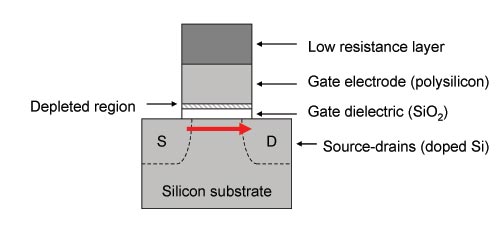
Current flows from source to drain when the transistor is on, and it isn’t supposed to flow when it’s off. Now as you shrink the transistor, all of its parts shrink. At 65nm Intel found that it couldn’t shrink the gate dielectric any more without leaking too much current through the gate itself. Back then the gate dielectric was 1.2nm thick (about the thickness of 5 atoms), but at 45nm Intel’s switched from a SiO2 gate dielectric to a high-k one using Hafnium. That’s where the high-k comes from.
The gate electrode also got replaced at 45nm with a metal to help increase drive current (more current flows when you want it to). That’s where the metal gate comes from.
The combination of the two changes to the basic transistor gave us Intel’s high-k + metal gate transistors at 45nm, and at 32nm we have the second generation of those improvements.
The high-k gate dielectric gets a little thinner (equivalent to a 0.9nm SiO2 gate, but presumably thicker since it’s Hafnium based, down from 1.0nm at 45nm ) and we’ve still got a metal gate.
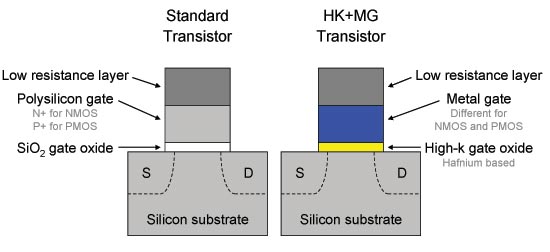
At 32nm the transistors are approximately 70% the size of Intel’s 45nm hk + mg transistors, allowing Intel to pack more in a smaller area.
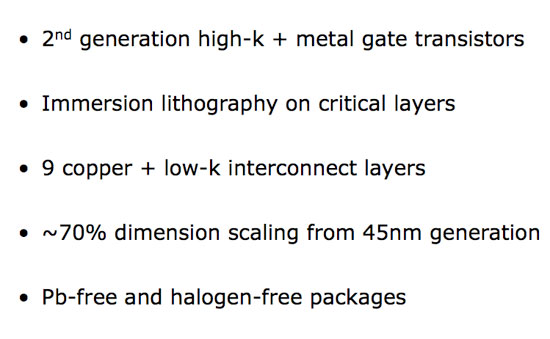
The big change here is that Intel is using immersion lithography on critical metal layers in order to continue to use existing 193nm lithography equipment. The smaller your transistors are, the higher resolution your equipment has to be in order to actually build them. Immersion lithography is used to increase the resolution of existing lithography equipment without requiring new technologies. It is a costlier approach, but one that becomes necessary as you scale below 45nm. Note that AMD to made the switch to immersion lithography at 45nm.
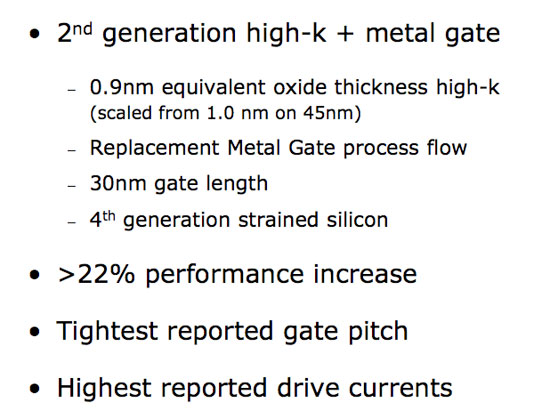
Intel reported significant gains in transistor performance at 32nm; the graphs below help explain:
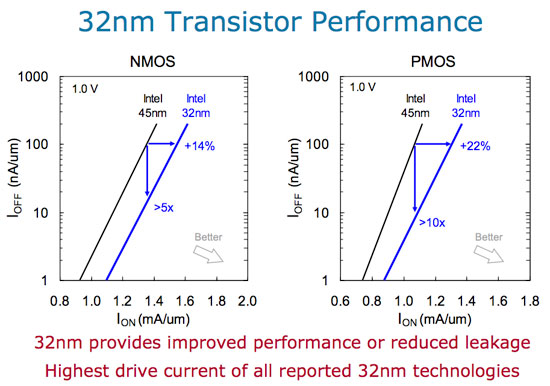
We’re looking at the comparison of leakage current vs. drive current for both 32nm NMOS and PMOS transistors. The new transistors showcase a huge improvement in power efficiency. You can either run them faster or run them at the same speed and significantly reduce leakage current by a magnitude of greater than 5 - 10x compared to Intel’s 45nm transistors. Intel claims that its 32nm transistors boast the highest drive current of all reported 32nm technologies at this point, which admittedly there aren’t many.
The power/performance characteristics of Intel’s 32nm process make it particularly attractive for mobile applications. But more on that later.










64 Comments
View All Comments
strikeback03 - Wednesday, February 11, 2009 - link
Might depend on who you buy the motherboard from. My motherboard is a P965 and is not Penryn compatible, though other P965 boards are. There might be both hardware (say, power delivery) and software (BIOS) considerations to future generation processors.haukionkannel - Wednesday, February 11, 2009 - link
Wery little change. Intel ghange their soccets when they do new architechture prosessor. Only reason would be that AMD would be so cpmpetative that there would be a real prize war... By making new soccet they can make more money!Nfarce - Wednesday, February 11, 2009 - link
"Now that isn’t to say that the six-core 32nm Gulftown will work in existing X58 motherboards; while that would be nice, Intel does have a habit of forcing motherboard upgrades, we’ll have to wait and see." Unfortunately, my trusty nearly three year old E6600/ASUS P5W croaked and I need a new build *now* (my PS3 is no real sub for PC gaming :p ). I was going to just go cheap and build an E8500/P45 rig, but after reading this, I'm debating whether I should just go ahead and throw down the extra several hundred on an i7 build for future upgrade insurance. I'm leaning more towards the latter.CSMR - Wednesday, February 11, 2009 - link
Great article; nice work putting it together so fast!weevil - Wednesday, February 11, 2009 - link
My question is this. I've got a QX9650 at 3.2ghz on an x38 asus P5E3 Deluxe. Is it worth upgrading anytime this year to the i7 or am I fast enough to hold out until the Quad Core Gulftown rolls around in early 2010?Decisions decisions...
ssj4Gogeta - Wednesday, February 11, 2009 - link
Gulftown is 6 cores. :)weevil - Wednesday, February 11, 2009 - link
Yikes!Yummy ; )
dickeywang - Wednesday, February 11, 2009 - link
I guess I'll just keep my Thinkpad T61p (Merom T7300) for another 10 months. Thanks AnandTech.ssj4Gogeta - Wednesday, February 11, 2009 - link
I think this is a very good move.Want the highest end? Go for i7 now and upgrade to Gulftown hexa-core next year.
Want a mainstream quad? buy lynnfield at the end of this year and upgrade to Sandy Bridge at the end of the next year.
Are satisfied with your E8x00, or another dual core and think quad-core is a waste of money? Go for Clarckdale at the end of this year.
Want to buy a notebook? The 32nm Arrandale will deliver excellent performance with great power savings and an on package graphics processor for even more power saving.
Want to buy a powerful quad-core notebook? Go for Nehalem based Clarcksfield 45nm, which should deliver quite a lot of performance over current mobile CPU's, with Nehalem's power saving features as well, but not as much power savings as Arrandale.
7Enigma - Wednesday, February 11, 2009 - link
I'm a bit dissapointed that the next top of the line chip will be 6-core instead of a pumped quad. We are still in multi-core infancy with very few programs taking advantage of anything over dual-core, and almost nothing taking FULL advantage of quad-core. I just don't see how 6-core will be more beneficial than a higher clocked 4-core...As it stands, however, if the power efficiency is legit my next computer may very well be a laptop.